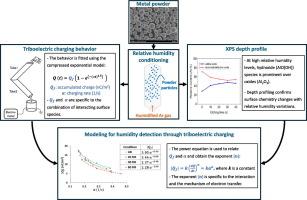Surface chemistry characterization of AA2014 aluminum alloy powder through triboelectric charging
IF 4.5
2区 工程技术
Q2 ENGINEERING, CHEMICAL
引用次数: 0
Abstract
Traditional characterization techniques for powders primarily focus on bulk properties, often neglecting the critical role of surface chemistry variations that influence the performance in applications such as additive manufacturing. The method presented in this work addresses this gap by utilizing triboelectric charging concept to gain a comprehensive understanding of powder surface state under varying environmental conditions. In particular, the study investigates the detection of surface chemistry variations of AA2014 powder caused by an exposure to various relative humidity (RH) levels through a change in triboelectric charging behavior. The surface variations are analyzed in parallel with X-ray photoelectron spectroscopy (XPS). The findings reveal a direct correlation between elevated RH and increased hydroxide species content at the surface of the powder. The triboelectric charging experiments demonstrated a significant RH-dependent variations of charge accumulation, with higher humidity levels leading to reduced static charge buildup on the powder particles. The charge accumulation behavior in the powder was fitted with the compressed exponential relaxation model. The results showed that each surface chemical species exhibits a distinct correlation between charging rate and charge accumulation, confirming the effectiveness of the method to detect subtle variations in surface chemistry. The variations in the exponent of the fitted model were shown to be characteristics to the surface scale of the powder particles.

通过三电荷对 AA2014 铝合金粉末进行表面化学表征
传统的粉末表征技术主要关注块体特性,往往忽视了表面化学变化的关键作用,而这些变化会影响粉末在增材制造等应用中的性能。本研究提出的方法利用三电荷概念来全面了解粉末在不同环境条件下的表面状态,从而弥补了这一不足。特别是,该研究通过改变三电充电行为,检测 AA2014 粉末在不同相对湿度 (RH) 条件下的表面化学变化。在分析表面变化的同时,还使用了 X 射线光电子能谱 (XPS)。研究结果表明,相对湿度升高与粉末表面氢氧化物物种含量增加之间存在直接关联。三电荷实验表明,电荷积累的变化与相对湿度密切相关,湿度越高,粉末颗粒上的静电荷积累越少。粉末中的电荷积累行为采用压缩指数弛豫模型进行拟合。结果表明,每种表面化学物质在充电速率和电荷积累之间都表现出明显的相关性,这证实了该方法在检测表面化学微妙变化方面的有效性。拟合模型指数的变化与粉末颗粒的表面尺度有关。
本文章由计算机程序翻译,如有差异,请以英文原文为准。
求助全文
约1分钟内获得全文
求助全文
来源期刊

Powder Technology
工程技术-工程:化工
CiteScore
9.90
自引率
15.40%
发文量
1047
审稿时长
46 days
期刊介绍:
Powder Technology is an International Journal on the Science and Technology of Wet and Dry Particulate Systems. Powder Technology publishes papers on all aspects of the formation of particles and their characterisation and on the study of systems containing particulate solids. No limitation is imposed on the size of the particles, which may range from nanometre scale, as in pigments or aerosols, to that of mined or quarried materials. The following list of topics is not intended to be comprehensive, but rather to indicate typical subjects which fall within the scope of the journal's interests:
Formation and synthesis of particles by precipitation and other methods.
Modification of particles by agglomeration, coating, comminution and attrition.
Characterisation of the size, shape, surface area, pore structure and strength of particles and agglomerates (including the origins and effects of inter particle forces).
Packing, failure, flow and permeability of assemblies of particles.
Particle-particle interactions and suspension rheology.
Handling and processing operations such as slurry flow, fluidization, pneumatic conveying.
Interactions between particles and their environment, including delivery of particulate products to the body.
Applications of particle technology in production of pharmaceuticals, chemicals, foods, pigments, structural, and functional materials and in environmental and energy related matters.
For materials-oriented contributions we are looking for articles revealing the effect of particle/powder characteristics (size, morphology and composition, in that order) on material performance or functionality and, ideally, comparison to any industrial standard.
 求助内容:
求助内容: 应助结果提醒方式:
应助结果提醒方式:


